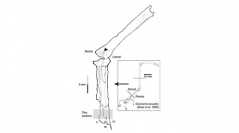

 Comptes Rendus Palevol
5 (5) - Pages 685-691
Comptes Rendus Palevol
5 (5) - Pages 685-691New material from a small, presumably adult enantiornithine bird (Saurischia: Aves) from the Lower Cretaceous of Las Hoyas (Spain) provides new data on the bone histology of those Mesozoic birds, which became extinct at the Cretaceous–Tertiary boundary. The material is referred to cf. Concornis lacustris. The outer cortex of the studied long bones is formed of a rather typical parallel-fibered bone tissue, with sparse flattened osteocyte lacunae, evidence of lines of arrested growth (LAGs) and no vascularization. This structure matches the outer circumferential layer (OCL) of many extant mature, small to tiny birds and also agrees with earlier descriptions of enantiornithine cortical bone. The deeper cortex progressively contains a much more plentiful component of osteocyte lacunae, which are more plump than flat. This region is also permeated by a few vascular canals surrounded by bone lamellae that form osteonal structures. The relationship of the osteonal material to the neighbouring primary tissue strongly suggests that the osteons are secondary. In some sections, it is possible to follow those osteons as formed by outward extensions from the endosteal bone tissue into the deep primary cortex. This specimen shows more histodiversity than the few enantiornithine samples previously reported. This further suggests that although growth may have been slow when the adult size was approached, it was more rapid at earlier stages. Even if as yet not enough is known of those early stages to document just how rapid early growth may have been, and whether enantiornithines grew differently from the basal avian models known from other early birds, the new data do not necessarily suggest that they had growth regimes quite distinct from extant birds of similar body sizes nor, by implication, completely different metabolic patterns or regimes.
Enantiornithines, histology, lines of arrested growth (LAGs), osteocyte lacunae